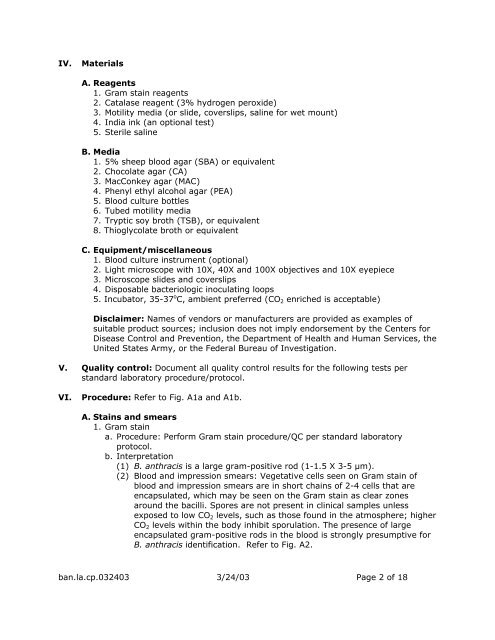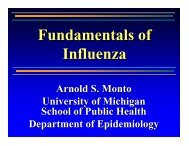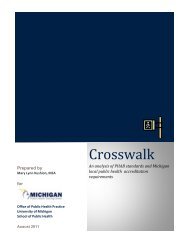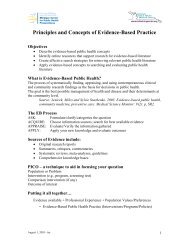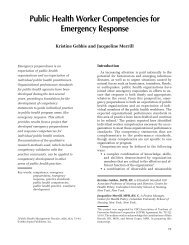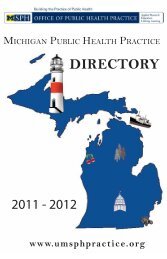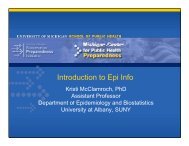Anthrax Lab Protocol - Office of Public Health Practice
Anthrax Lab Protocol - Office of Public Health Practice
Anthrax Lab Protocol - Office of Public Health Practice
Create successful ePaper yourself
Turn your PDF publications into a flip-book with our unique Google optimized e-Paper software.
IV. Materials<br />
A. Reagents<br />
1. Gram stain reagents<br />
2. Catalase reagent (3% hydrogen peroxide)<br />
3. Motility media (or slide, coverslips, saline for wet mount)<br />
4. India ink (an optional test)<br />
5. Sterile saline<br />
B. Media<br />
1. 5% sheep blood agar (SBA) or equivalent<br />
2. Chocolate agar (CA)<br />
3. MacConkey agar (MAC)<br />
4. Phenyl ethyl alcohol agar (PEA)<br />
5. Blood culture bottles<br />
6. Tubed motility media<br />
7. Tryptic soy broth (TSB), or equivalent<br />
8. Thioglycolate broth or equivalent<br />
C. Equipment/miscellaneous<br />
1. Blood culture instrument (optional)<br />
2. Light microscope with 10X, 40X and 100X objectives and 10X eyepiece<br />
3. Microscope slides and coverslips<br />
4. Disposable bacteriologic inoculating loops<br />
5. Incubator, 35-37 o C, ambient preferred (CO 2 enriched is acceptable)<br />
Disclaimer: Names <strong>of</strong> vendors or manufacturers are provided as examples <strong>of</strong><br />
suitable product sources; inclusion does not imply endorsement by the Centers for<br />
Disease Control and Prevention, the Department <strong>of</strong> <strong>Health</strong> and Human Services, the<br />
United States Army, or the Federal Bureau <strong>of</strong> Investigation.<br />
V. Quality control: Document all quality control results for the following tests per<br />
standard laboratory procedure/protocol.<br />
VI. Procedure: Refer to Fig. A1a and A1b.<br />
A. Stains and smears<br />
1. Gram stain<br />
a. Procedure: Perform Gram stain procedure/QC per standard laboratory<br />
protocol.<br />
b. Interpretation<br />
(1) B. anthracis is a large gram-positive rod (1-1.5 X 3-5 µm).<br />
(2) Blood and impression smears: Vegetative cells seen on Gram stain <strong>of</strong><br />
blood and impression smears are in short chains <strong>of</strong> 2-4 cells that are<br />
encapsulated, which may be seen on the Gram stain as clear zones<br />
around the bacilli. Spores are not present in clinical samples unless<br />
exposed to low CO 2 levels, such as those found in the atmosphere; higher<br />
CO 2 levels within the body inhibit sporulation. The presence <strong>of</strong> large<br />
encapsulated gram-positive rods in the blood is strongly presumptive for<br />
B. anthracis identification. Refer to Fig. A2.<br />
ban.la.cp.032403 3/24/03 Page 2 <strong>of</strong> 18


